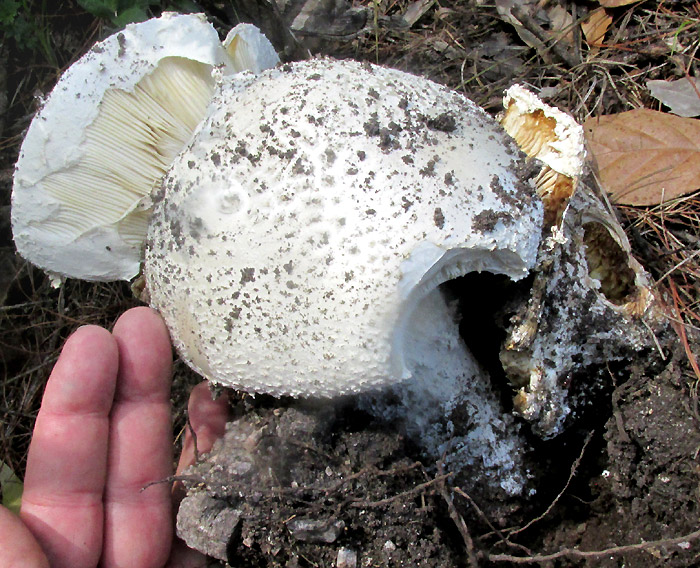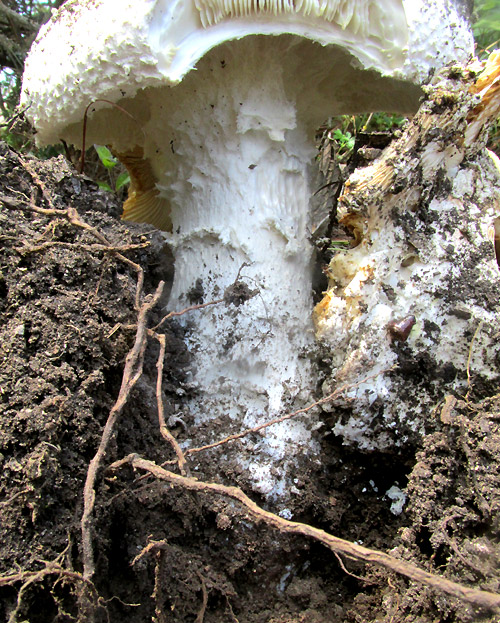Excerpts from Jim Conrad's
Naturalist Newsletter
Entry from field notes dated September 2, 2023, taken in Los Mármoles National Park in the Eastern Sierra Madre mountains, Hidalgo state, MÉXICO; oak-pine forested slope about 3km west of Puerto de Piedra, on road branched off the road between Trancas {on maps designated "Morelos (Trancas)"} and Nicolás Flores; limestone bedrock; elevation ~2,620m (~8,600ft); N20.816°, W99.213°
MESOAMERICAN MATSUTAKE

The above big mushrooms appeared to be struggling to emerge from the soil -- possibly because for the last two years this area has suffered from a continuing two-year drought, so the soil has dried hard. Something has been eating on the mushrooms' caps. On the picture's right side, part of an emerging mushroom's cap appears to have become stuck as it emerged, the whole mushroom becoming contorted as well as munched-on.

The mushroom's stem, or stipe, was unusually thick, and covered with a kind of shaggy scaliness. The stem arose from no cup, or volva; no ring, or annulus, surrounded the stalk's upper part like a collar or skirt. The surprising feature in the above picture is seen at the picture's top, where in the eaten part of the cap exposes the mushroom's gills in cross-section. The feature to note is that the gills can't release their spores because immediately beneath them there's a thick, white layer of tissue. Here's a view of that layer of tissue as seen from below:

The layer of tissue is the cortina, which consists of the remains of the young mushroom's partial veil. The partial veil is a temporary layer of tissue protecting the developing gills by enclosing them in an environment where humidity and temperature can be better regulated. The cortina is different from the universal veil seen on many mushroom species, because a universal veil covers the entire cap and extends down beyond the margin to form the ring encircling the stem. Cortinas occur on immature mushrooms of only a small fraction of species, so this is an important field mark. Also, by being so large while still bearing cortinas covering their gills, it's apparent that our big mushrooms are planning to grow even larger.
Using MushroomExpert.Com's identification key while making educated guesses on such details as spore color, and focusing on the main field marks of the mushroom's large size, thick stem, presence of a cortina, and its growing in a coniferous forest, the possibilities could be narrowed down to three or four genera. Scanning labeled pictures on the Internet featuring species in the various candidate genera, it appeared that the most likely genus was tricholoma. Tricholoma species occur worldwide, and are thought of as forest dwelling, and as existing in a symbiotic relationship with various tree species. The famously edible East Asian Matsutake is a Tricholoma.
Among Tricholoma species found in Mexico, pictures best matching our mushrooms were labeled as TRICHOLOMA MESOAMERICANUM, known in English as the Mesoamerican Matsutake. It's known to occur in certain conifer forests of our part of highland central Mexico -- at least before it was over-picked for sale in markets.
I hesitated about that ID because most pictures of the species usually show fairly smooth caps and stems not as flaky as ours. However, the few pictures found of immature mushrooms with the cortina still in place or mostly in place displayed such rough-textured caps as ours.
Tricholoma mesoamericanum wasn't known as a distinct species before it was published as so in 2017 by Steven Trudell and others in a study entitled "North American matsutake: Names clarified and a new species described." In that work it's shown that our Mesoamerican Matsutake is one of several species in a cluster of very closely related species centered around Tricholoma matsutake, the "real" matsutake, which authors describe as having great commercial and cultural significance in Japan. The author's genetic studies find that worldwide three main groups of matsutake species occur: Eurasia and North Africa; western North America, and; in Mexico/Mesoamerica. The habitat of Tricholoma mesoamericanum is described as oak-pine forests subject to summer rainfall, most abundantly occurring in the Mexican states of Oaxaca, Veracruz, México and here in Hidalgo, at elevations between 2000-3000m.
The 2021 study by Abimael López-Hernánez and others entitled "Recolección, Comercialización y Consumo de Hongos Silvestres en la Región Mixteca de Oaxaca, México" describes Tricholoma mesoamericanum in Oaxaca state as much commercialized for its edibility, but hard to find because they grow in places difficult to access, and are not common. Consequently, in markets they are considered to be expensive. The authors found that in Oaxaca the species was the fifth-most appreciated edible mushroom. In Oaxaca their main use is in making mole, which from what I've seen is a dark, thick, greasy gravy that's poured atop rice dishes, quesadillas (hot tortilla folded over something like refried beans along with cheese) and various dishes of cooked animal flesh.
Not only are Mesoamerican Matsutakes eaten within Mexico, but they are exported. This accounts for The Global Fungal Red List Initiative as listing the species as "Endangered (EN) category under A2d criteria because based in the actual levels of exploitation it has suffered a conservative estimated population reduction of more than 50% in the past 30 years and the causes of that decline have not ceased."
The above Red List also explains that all matsutake species everywhere are threatened by the same economic interests, and by the same bad collecting practice. When collected, the soil is raked to expose young mushroom "buttons," which kills the soil's mycelia from which the mushrooms arise. Mushroom buttons are the immature mushrooms before their caps expand.
At this writing, on the Internet, RegalisFoods.com, of the US offers one pound of "Wild Matsutake" or "Pine Mushrooms" for US$40.00. They confirm the diminishing availability of this mushroom and remark that it's ".. largely due to the proliferation of the pine-killing nematode, Bursaphelenchus xylophilus." Thus not only are Mesoamerican Matsutake disappearing because of bad collecting techniques, but also because of a nematode killing of the pines with whom they share their symbiotic mycorrhizal relationship. And then, there's climate change and our ongoing drought.